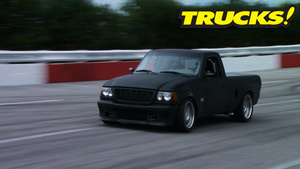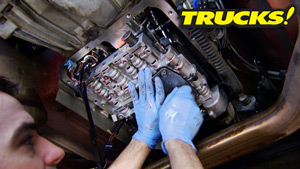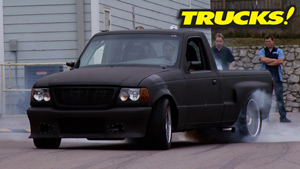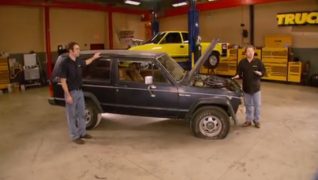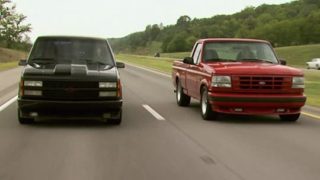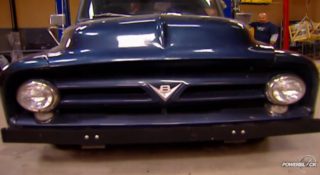Trucks! Builds
Want more content like this?
Join the PowerNation Email NewsletterParts Used In This Episode
Al's Liner
Al's Liner Urethane/Acrylic Coating System, is designed to be the markets first and only professional grade urethane coating for Do-it-Yourselfers.
Dick Cepek
The DC Torque with it's incredible flat black finish, machined accents, and tough satin clear coat really stands out from the crowd. 20x95x150.
Hypertech
Inline Speedometer Calibration Tool.
K&N
A sister product to the 57 Series FIPK, the 63 Series Intake Kits or AirCharger┬о Intakes are built for many different vehicles and represent a dramatic improvement over a K&N O/E replacement filter alone. Built for performance and show utilizing the highest quality components, the K&N 77 Series High-Flow Performance Kit is a free-flowing mandrel-bent aluminum tube induction system designed for Trucks and Sport Utility Vehicles. 77-Series intakes have a polished aluminum finish.
Matco Tools
Matco mobile strut and spring compressor.
Mickey Thompson
35x12.50R20 Mickey Thompson BAJA ATZ.
Skyjacker
Suspension Lift Kit, 6 in. Lift, Incl. Knuckles Pr., Front/Rear Crossmembers, Rear Springs and Brake Lines.
Tom Wood's Custom Drive Shafts
Driveshafts, Drivelines, 4X4, four wheel drive, truck, Custom Conversion/s, Lifted, Modified, Ford, Jeep, Chevrolet, GM, Landrover, Discovery, Toyota, High Angle, CV, Double Cardan, Long travel, Rockcrawler, 1350, series, bad boy, flex, technical information, Fixed yoke kits, slip yoke eliminator, SYE, tail shaft conversion/s, XJ, YJ, TJ, CJ, ZJ, KJ, Rubicon, best, price, quality, and service.
UniChip
Pre-programmed OBD map for Performance ECU mapping & tuning.
Episode Transcript
Hey, welcome to trucks. Well, today we get to work on a truck that a lot of you guys have asked us to take a little closer look at and one that's made quite a presence in the full size truck world, the Toyota tundra
and based on their success in the compact truck market, well, a few years back, Toyota took a gamble and entered the full size ring with the big boys with the tundra making its debut in model year 2000, picking up the truck of the year award as it hit the showroom floors. Toyota has continued to be very competitive in NASCAR truck racing since 2004 and has formed an alliance with Ivan Iron Man Stewart to become an incredibly successful desert racing team.
And on the street, it's earned its way to becoming the best selling full size half ton import truck.
This 08 tundra features the 5.7 L I Force V8 and it's the fully loaded four door, double cab model
and the long list of standard features. What draw a lot of people to it at the show room even though it's base price. That's a couple grand more than the entry level Ford Dodge or Chevy. The standard options include things like a factory limited slip, huge four wheel disc brakes and defeat
stability and traction control.
So in some ways, it's safe to say that the Toyota is a little bit ahead of its competition right out of the gate.
Now, motor trend thought enough of the 08 model to give tundra a second truck of the year one. And although there was a couple of hiccups when this model first came out, all of that's taken care of now. And the result is a solid well rounded truck that has its competitors attention.
So today we're gonna do what we do best and take something that's already good
and make it a little bit better with parts that are available to you guys in the aftermarket and that starts getting that thing up in the air a little bit
six inches higher to be exact. Thanks to Skyjacker suspensions. Now, this system is brand new from Skyjack and includes everything you need to lift up your tundra, including these cross members and drop brackets, new extended front struts, all the hardware you need and cast, drop, front knuckles, even sway bar and links so you can reconnect your factory anti roll bar. They also include dot approved braided stainless brake lines for all four corners. And since this is a brand new truck, we opted for the soft dried leaf spring packs to raise the altitude out back.
The detailed instructions that come with Skyjacker's lift, show you how to install the entire lift with the truck sitting on jack stands.
But since we've got a lift in our shop, we're going to use it since it makes it a little easier for us to work and a lot easier to show you guys how to do this kit.
This assembly is pretty straightforward
and it's clearly laid out in the skyjacker instruction sheets.
And as usual, it's important to keep up with all the stock fasters and where they came from since some of them will be reused, since we've got to remove the CV axles, pubs and knuckles anyway,
because sometimes it's just easier to remove it as an assembly and just work on it on a bench top.
Thank you.
Now, what comes with this kit is almost as interesting as what doesn't come with it and that is replacement front coil springs.
This system reuses the factory coil springs and just replaces the oe stress with these new longer skyjacker performance stress which saves you money and simply repurpose the engineering that Toyota has already invested in their suspension.
If you don't have a
compressor, like the one that we got from Matco, you can take your oe struts into a service station and have them swapped out for a small fee. It'll probably cost you about an hour's labor for both sides or just break them down yourself with a rental tool and reinstall the factory springs out of the new Skyjacker struts.
Now, you guys probably noticed we remove this knuckle in CV shaft as an assembly and here's why
we ran into a little bit of a problem. Most of you guys will probably run into when working on a late model Toyota like this. Now, despite our large collection of Macco tools, we didn't have a 12 point metric socket large enough to fit the axle retaining nut. So rather than go out and drop a chunk of change on an expensive socket, we'll probably never use again.
Here's our home brew solution.
We simply cut the box end off an inch and a half wrench. It was still a tight fit on the metric nut. So we cut a small slit into it to allow it to expand a bit
and we just welded it to a cheap half inch drive socket
that'll keep you from getting stopped in tracks in the middle of a project.
Skyjacker uses these dropped cross member brackets to retain the factory geometry and give us the altitude we need.
So with the differential supported, we'll remove the left and right differential brackets.
Now, when the differential drops, so does the drive shaft. So we need to get rid of this cross member to create the clearance that we need. So we've measured out three and three eights inch from the inside of the frame rail and we'll just make our first cut right here.
The Sawzall really gets the job done.
The passenger side is cut as well. This time 2.5 inches in.
Now, Skyjacker has thought this through and even includes these caps to re weld the empty holes. This puts back some of the strength that may have been removed by altering the factory cross member
and it cleans things up a little under here.
Hey, welcome back to trucks where we're working on the truck of the year in 08 Toyota Tundra double cab four by four. And we're giving it a six inch lift with the help of skyjacker.
And so far, we've got the front end prep with the factory cross member cut out in the open ends capped and painted. Now we also ground down the alignment tabs that are on the front side of both front cross members. Now we're ready to throw in some new parts.
So why would we go and start changing around a truck that's already pretty darn capable. Well, the obvious answer to that is to separate it from the crowd a little bit, create some wheel and tire clearance and make this thing look a little better.
The front cross members bolt into the frame using the provided hardware.
Now both the factory differential brackets back on the diff
and then
attach the di
to the new cross members using factory hardware.
The factory bomb stops get removed from the frame
and put back on the new drop rackets.
Now, we can install both lower a arms.
I
we removed the knuckles and shafts as an assembly before the break
and rebuilding them is simple too
and starts with removing the hub berry from the oe knuckle
and carefully driving up the Bering seal with a large flat screwdriver
and reinstalling it into the skyjacker knuckle.
The dust shield is followed by the bearing
and the new steering knuckle. Ready to go back on the truck
with the lower strut mount installed on the A arm. Next seat, the CV shafts back into the dip.
Then we install the new steering knuckles onto the lower ball joint.
I
don't
lie.
I
clar you,
the CV shafts get reinstalled using our homemade socket.
After lining up the upper strut mount,
we can put the weight of the vehicle on a jack stand and let it down off the lift a little
after tightening the upper strut mount nuts,
we can persuade the A arm down a little bit and install it into the new knuckles
with the giant rotors and calibers back on the hub.
Then we can reconnect the A BS line.
Now with this lift height. Well, there's just not enough slack in the factory rubber flex line. So Skyjacker supplies these dot approved extended brake lines and sensitive the stainless steel type.
Well, it ought to give you a little bit firmer feel to the pedal when you apply the brakes
with the new knuckles. A tie rod end goes in from the top with the old knuckles. It went in from the bottom. This is to maintain steering geometry. And Skyjacker wants you to switch the tie rod ends from left to right. And that's to maintain the clearance that you need with the new knuckles. As you can see, I've marked my jam nut with a piece of tape
that's going to keep my alignment close, so I can possibly even drive this thing back to the alignment shop
before reinstalling the factory sway bar. We install the new drop rackets.
Then the oe sway bar gets set into place
and finally connected with the longer end links that come with a kit
right here where the factory steering stops are.
You'll need to weld in the provided spacers to keep your tires from contacting the frame.
When we come back, we'll get the rear lift in place. Stay tuned.
Hey, welcome back and thanks for sticking with us as we elevate this 08 Thunder, a full six inches over its factory stance.
And if you're just now joining us, well, here's a quick look back at what we've already done today.
We've removed the front suspension,
assembled the new steering knuckles
and outfitted the skyjacker struts with the oe coil springs.
We also cut out the factory rear cross member to allow for drive shaft and differential clearance.
Next, we installed the new skyjacker cross members,
drop rackets and sway bar mounts
and finished up by reconnecting the A BS sensors and welding on new steering stop spacers to keep our new tires from rubbing the frame.
Now with the front all buttoned up, it's time to elevate the back
and that starts by supporting the rear axle,
removing the rear U bolts
next to the rear shots
with everything disconnected. You can just remove the front eye bolt
and disconnect the other end at the shackle,
you got it.
The new soft dried
leaf spring packs are relatively easy to install.
The heavy lifting was definitely on the front suspension which is typical on a four wheel drive lift with independent suspension.
These skyjacker nitro 8000 shocks don't come with a kit
but they're available anywhere that you can get skyjacker parts
since this truck is so new, it's safe for us to use the original mounting hardware to put these things on.
After installing the rear extended brake lines
to finish up the rear suspension, we threw on the charcoal canister line relocation bracket.
And since this is a long two piece drive shaft for the keep drive shaft vibrations at bay, we also installed the provided skyjacker carrier bearing spacer kit.
I like the rest of this truck. These wheels and tires are practically brand new. They still got that little nebulas on the side, but look at the tread pattern. This is not going to be much for off road and the styling, well, with a six inch lift on this tundra, it's gonna look a little goofy. So we opted for these 35 inch Mickey Thompson Baha A TZ radios. It's a pretty mild all terrain. That's a good thing because this truck
mostly gonna see street use. But when it does go off road, we'll still have a decent amount of traction.
We wrapped them around these aluminum 20 by nine inch Dixie Peck DC torque wheels got a nice flat black powder coat finish with a cool looking silver accent. Now, obviously these larger diameter tires, well, they're gonna throw off your Speedo.
Nobody wants to see that.
So we're using hypertext speedometer recalibration unit. It's pretty simple to install. It basically intercepts the factory signal, modifies it according to the tire size you program into it
and sends it on to the speedometer
after the break. We're upping the horsepower under the hood. Don't go away.
Hey, welcome back to trucks. Well, we've got this 08 full size tundra looking mean sitting on a six inch skyjacker lip and Mickey Thompson tires and Dick CPC
wheels finish it off.
Now, all this thing needs is a trip to the alignment shop thing will be ready for a test drive. Now, adding larger and heavier rolling stock to a truck. Well, it doesn't help with fuel economy and that big 57 and a full size
tundra. Well, it's kind of thirsty to begin with. So what can you do to a lifted truck to help out with fuel economy? Well, one of the easiest ways thanks is to make it more efficient. And one of the ways we can do that is just to let it breathe a little better. So we're going to do that by installing this KNN high flow filter system in place of the restrictive factory air box. All right, with the stock air box out of the way. And before we install the KNN, well, we wanted to try to pull some more power out of the engine. Now, you've seen us use chips and programmers on the show
quite a bit in the past and for good reason, they work, but the aftermarket has been slow to come out with programmers or electronic tuners for these import trucks. Well, until now that is unit just came out with this chip for the OSE
and 08 Toyota Tundra.
It's basically an intercept module that plugs in between the factory ECU and the harness.
The module itself gets velcro to a safe place under the hood and plugged in.
It'll add about 25 horsepower and about 25 ft pounds of torque to this truck. But the best thing is that it won't leave any kind of electronic footprint on the engine computer that could show up at the service center
and you can get upgrades from Unic chip if you decide to mess with the exhaust a little bit or you can go back to a stock air intake set up
with the chip in place. The KNN system goes in, starting with the heat shield.
Everything fits great. And these kits come in plastic or chrome to suit your taste.
Now, both systems bolt on using the stock mass airflow sensor. So there are no vehicle warranty hassles and they both have Canaan's million mile element that increases filtering capacity, improves airflow and throttle response. The best part of all on a truck like our tundra,
it installs in about half an hour.
We've decided to use the molded tube version because it will deliver an extra 14 plus horsepower.
Well, there you go a relatively easy to install lift, 20 inch wheels and 35 inch tires make an already good looking full size Toyota tundra look even better. And on a truck, this huge or bigger tires and wheels are almost a requirement. And what you end up with is a tough, good looking truck that's still usable. It sets you apart from the crowd a little bit.
Well, here's a spray on liner kit that's much more than just a bed liner. This is
Owl's liner kit and it's great for pickup beds, but also undercoating of almost any kind truck beds frames, inner bodies and it doubles as a sound. Dead
Owl's liner is a heavy duty acrylic polyurethane coating and they offer their own spray gun with a five point nozzle for nice atomization and a 1.25 gallon hopper.
This is a non skid and 100% UV and chemical resistant system. And Al's offers a couple of different colors, but you can use automotive toners added in and color match to your vehicle. The kit starts at about 95 bucks. The gun, about 55. You can pick it up at Als
liner.com. Now you've seen us use Tom Woods custom drive shafts on the show before and for good reason, they're pretty darn tough, but there's a few things that separates a Tom wood shaft from the rest. One of them is the
fully warranty gold seal universal joints and the use of steel instead of weaker cast iron to check this out. They've also replaced the needle bearings in the CV socket with the bronze bushing for better load distribution. Then they surrounded it with a low friction material to keep heat down. Another feature is the reshaped CV assembly for greater flexibility. And Tom Woods custom drive shafts are available at many four wheel drive retailers or directly from Tom Woods. Thanks for watching trucks. See you guys next week.
Show Full Transcript
and based on their success in the compact truck market, well, a few years back, Toyota took a gamble and entered the full size ring with the big boys with the tundra making its debut in model year 2000, picking up the truck of the year award as it hit the showroom floors. Toyota has continued to be very competitive in NASCAR truck racing since 2004 and has formed an alliance with Ivan Iron Man Stewart to become an incredibly successful desert racing team.
And on the street, it's earned its way to becoming the best selling full size half ton import truck.
This 08 tundra features the 5.7 L I Force V8 and it's the fully loaded four door, double cab model
and the long list of standard features. What draw a lot of people to it at the show room even though it's base price. That's a couple grand more than the entry level Ford Dodge or Chevy. The standard options include things like a factory limited slip, huge four wheel disc brakes and defeat
stability and traction control.
So in some ways, it's safe to say that the Toyota is a little bit ahead of its competition right out of the gate.
Now, motor trend thought enough of the 08 model to give tundra a second truck of the year one. And although there was a couple of hiccups when this model first came out, all of that's taken care of now. And the result is a solid well rounded truck that has its competitors attention.
So today we're gonna do what we do best and take something that's already good
and make it a little bit better with parts that are available to you guys in the aftermarket and that starts getting that thing up in the air a little bit
six inches higher to be exact. Thanks to Skyjacker suspensions. Now, this system is brand new from Skyjack and includes everything you need to lift up your tundra, including these cross members and drop brackets, new extended front struts, all the hardware you need and cast, drop, front knuckles, even sway bar and links so you can reconnect your factory anti roll bar. They also include dot approved braided stainless brake lines for all four corners. And since this is a brand new truck, we opted for the soft dried leaf spring packs to raise the altitude out back.
The detailed instructions that come with Skyjacker's lift, show you how to install the entire lift with the truck sitting on jack stands.
But since we've got a lift in our shop, we're going to use it since it makes it a little easier for us to work and a lot easier to show you guys how to do this kit.
This assembly is pretty straightforward
and it's clearly laid out in the skyjacker instruction sheets.
And as usual, it's important to keep up with all the stock fasters and where they came from since some of them will be reused, since we've got to remove the CV axles, pubs and knuckles anyway,
because sometimes it's just easier to remove it as an assembly and just work on it on a bench top.
Thank you.
Now, what comes with this kit is almost as interesting as what doesn't come with it and that is replacement front coil springs.
This system reuses the factory coil springs and just replaces the oe stress with these new longer skyjacker performance stress which saves you money and simply repurpose the engineering that Toyota has already invested in their suspension.
If you don't have a
compressor, like the one that we got from Matco, you can take your oe struts into a service station and have them swapped out for a small fee. It'll probably cost you about an hour's labor for both sides or just break them down yourself with a rental tool and reinstall the factory springs out of the new Skyjacker struts.
Now, you guys probably noticed we remove this knuckle in CV shaft as an assembly and here's why
we ran into a little bit of a problem. Most of you guys will probably run into when working on a late model Toyota like this. Now, despite our large collection of Macco tools, we didn't have a 12 point metric socket large enough to fit the axle retaining nut. So rather than go out and drop a chunk of change on an expensive socket, we'll probably never use again.
Here's our home brew solution.
We simply cut the box end off an inch and a half wrench. It was still a tight fit on the metric nut. So we cut a small slit into it to allow it to expand a bit
and we just welded it to a cheap half inch drive socket
that'll keep you from getting stopped in tracks in the middle of a project.
Skyjacker uses these dropped cross member brackets to retain the factory geometry and give us the altitude we need.
So with the differential supported, we'll remove the left and right differential brackets.
Now, when the differential drops, so does the drive shaft. So we need to get rid of this cross member to create the clearance that we need. So we've measured out three and three eights inch from the inside of the frame rail and we'll just make our first cut right here.
The Sawzall really gets the job done.
The passenger side is cut as well. This time 2.5 inches in.
Now, Skyjacker has thought this through and even includes these caps to re weld the empty holes. This puts back some of the strength that may have been removed by altering the factory cross member
and it cleans things up a little under here.
Hey, welcome back to trucks where we're working on the truck of the year in 08 Toyota Tundra double cab four by four. And we're giving it a six inch lift with the help of skyjacker.
And so far, we've got the front end prep with the factory cross member cut out in the open ends capped and painted. Now we also ground down the alignment tabs that are on the front side of both front cross members. Now we're ready to throw in some new parts.
So why would we go and start changing around a truck that's already pretty darn capable. Well, the obvious answer to that is to separate it from the crowd a little bit, create some wheel and tire clearance and make this thing look a little better.
The front cross members bolt into the frame using the provided hardware.
Now both the factory differential brackets back on the diff
and then
attach the di
to the new cross members using factory hardware.
The factory bomb stops get removed from the frame
and put back on the new drop rackets.
Now, we can install both lower a arms.
I
we removed the knuckles and shafts as an assembly before the break
and rebuilding them is simple too
and starts with removing the hub berry from the oe knuckle
and carefully driving up the Bering seal with a large flat screwdriver
and reinstalling it into the skyjacker knuckle.
The dust shield is followed by the bearing
and the new steering knuckle. Ready to go back on the truck
with the lower strut mount installed on the A arm. Next seat, the CV shafts back into the dip.
Then we install the new steering knuckles onto the lower ball joint.
I
don't
lie.
I
clar you,
the CV shafts get reinstalled using our homemade socket.
After lining up the upper strut mount,
we can put the weight of the vehicle on a jack stand and let it down off the lift a little
after tightening the upper strut mount nuts,
we can persuade the A arm down a little bit and install it into the new knuckles
with the giant rotors and calibers back on the hub.
Then we can reconnect the A BS line.
Now with this lift height. Well, there's just not enough slack in the factory rubber flex line. So Skyjacker supplies these dot approved extended brake lines and sensitive the stainless steel type.
Well, it ought to give you a little bit firmer feel to the pedal when you apply the brakes
with the new knuckles. A tie rod end goes in from the top with the old knuckles. It went in from the bottom. This is to maintain steering geometry. And Skyjacker wants you to switch the tie rod ends from left to right. And that's to maintain the clearance that you need with the new knuckles. As you can see, I've marked my jam nut with a piece of tape
that's going to keep my alignment close, so I can possibly even drive this thing back to the alignment shop
before reinstalling the factory sway bar. We install the new drop rackets.
Then the oe sway bar gets set into place
and finally connected with the longer end links that come with a kit
right here where the factory steering stops are.
You'll need to weld in the provided spacers to keep your tires from contacting the frame.
When we come back, we'll get the rear lift in place. Stay tuned.
Hey, welcome back and thanks for sticking with us as we elevate this 08 Thunder, a full six inches over its factory stance.
And if you're just now joining us, well, here's a quick look back at what we've already done today.
We've removed the front suspension,
assembled the new steering knuckles
and outfitted the skyjacker struts with the oe coil springs.
We also cut out the factory rear cross member to allow for drive shaft and differential clearance.
Next, we installed the new skyjacker cross members,
drop rackets and sway bar mounts
and finished up by reconnecting the A BS sensors and welding on new steering stop spacers to keep our new tires from rubbing the frame.
Now with the front all buttoned up, it's time to elevate the back
and that starts by supporting the rear axle,
removing the rear U bolts
next to the rear shots
with everything disconnected. You can just remove the front eye bolt
and disconnect the other end at the shackle,
you got it.
The new soft dried
leaf spring packs are relatively easy to install.
The heavy lifting was definitely on the front suspension which is typical on a four wheel drive lift with independent suspension.
These skyjacker nitro 8000 shocks don't come with a kit
but they're available anywhere that you can get skyjacker parts
since this truck is so new, it's safe for us to use the original mounting hardware to put these things on.
After installing the rear extended brake lines
to finish up the rear suspension, we threw on the charcoal canister line relocation bracket.
And since this is a long two piece drive shaft for the keep drive shaft vibrations at bay, we also installed the provided skyjacker carrier bearing spacer kit.
I like the rest of this truck. These wheels and tires are practically brand new. They still got that little nebulas on the side, but look at the tread pattern. This is not going to be much for off road and the styling, well, with a six inch lift on this tundra, it's gonna look a little goofy. So we opted for these 35 inch Mickey Thompson Baha A TZ radios. It's a pretty mild all terrain. That's a good thing because this truck
mostly gonna see street use. But when it does go off road, we'll still have a decent amount of traction.
We wrapped them around these aluminum 20 by nine inch Dixie Peck DC torque wheels got a nice flat black powder coat finish with a cool looking silver accent. Now, obviously these larger diameter tires, well, they're gonna throw off your Speedo.
Nobody wants to see that.
So we're using hypertext speedometer recalibration unit. It's pretty simple to install. It basically intercepts the factory signal, modifies it according to the tire size you program into it
and sends it on to the speedometer
after the break. We're upping the horsepower under the hood. Don't go away.
Hey, welcome back to trucks. Well, we've got this 08 full size tundra looking mean sitting on a six inch skyjacker lip and Mickey Thompson tires and Dick CPC
wheels finish it off.
Now, all this thing needs is a trip to the alignment shop thing will be ready for a test drive. Now, adding larger and heavier rolling stock to a truck. Well, it doesn't help with fuel economy and that big 57 and a full size
tundra. Well, it's kind of thirsty to begin with. So what can you do to a lifted truck to help out with fuel economy? Well, one of the easiest ways thanks is to make it more efficient. And one of the ways we can do that is just to let it breathe a little better. So we're going to do that by installing this KNN high flow filter system in place of the restrictive factory air box. All right, with the stock air box out of the way. And before we install the KNN, well, we wanted to try to pull some more power out of the engine. Now, you've seen us use chips and programmers on the show
quite a bit in the past and for good reason, they work, but the aftermarket has been slow to come out with programmers or electronic tuners for these import trucks. Well, until now that is unit just came out with this chip for the OSE
and 08 Toyota Tundra.
It's basically an intercept module that plugs in between the factory ECU and the harness.
The module itself gets velcro to a safe place under the hood and plugged in.
It'll add about 25 horsepower and about 25 ft pounds of torque to this truck. But the best thing is that it won't leave any kind of electronic footprint on the engine computer that could show up at the service center
and you can get upgrades from Unic chip if you decide to mess with the exhaust a little bit or you can go back to a stock air intake set up
with the chip in place. The KNN system goes in, starting with the heat shield.
Everything fits great. And these kits come in plastic or chrome to suit your taste.
Now, both systems bolt on using the stock mass airflow sensor. So there are no vehicle warranty hassles and they both have Canaan's million mile element that increases filtering capacity, improves airflow and throttle response. The best part of all on a truck like our tundra,
it installs in about half an hour.
We've decided to use the molded tube version because it will deliver an extra 14 plus horsepower.
Well, there you go a relatively easy to install lift, 20 inch wheels and 35 inch tires make an already good looking full size Toyota tundra look even better. And on a truck, this huge or bigger tires and wheels are almost a requirement. And what you end up with is a tough, good looking truck that's still usable. It sets you apart from the crowd a little bit.
Well, here's a spray on liner kit that's much more than just a bed liner. This is
Owl's liner kit and it's great for pickup beds, but also undercoating of almost any kind truck beds frames, inner bodies and it doubles as a sound. Dead
Owl's liner is a heavy duty acrylic polyurethane coating and they offer their own spray gun with a five point nozzle for nice atomization and a 1.25 gallon hopper.
This is a non skid and 100% UV and chemical resistant system. And Al's offers a couple of different colors, but you can use automotive toners added in and color match to your vehicle. The kit starts at about 95 bucks. The gun, about 55. You can pick it up at Als
liner.com. Now you've seen us use Tom Woods custom drive shafts on the show before and for good reason, they're pretty darn tough, but there's a few things that separates a Tom wood shaft from the rest. One of them is the
fully warranty gold seal universal joints and the use of steel instead of weaker cast iron to check this out. They've also replaced the needle bearings in the CV socket with the bronze bushing for better load distribution. Then they surrounded it with a low friction material to keep heat down. Another feature is the reshaped CV assembly for greater flexibility. And Tom Woods custom drive shafts are available at many four wheel drive retailers or directly from Tom Woods. Thanks for watching trucks. See you guys next week.



